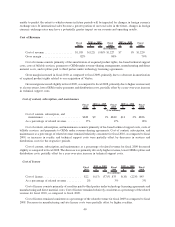Symantec 2010 Annual Report Download - page 111
Download and view the complete annual report
Please find page 111 of the 2010 Symantec annual report below. You can navigate through the pages in the report by either clicking on the pages listed below, or by using the keyword search tool below to find specific information within the annual report.
may revise our estimates. Any revisions in the estimates of potential liabilities could have a material impact on our
operating results and financial position.
Income Taxes
We are required to compute our income taxes in each federal, state, and international jurisdiction in which we
operate. This process requires that we estimate the current tax exposure as well as assess temporary differences
between the accounting and tax treatment of assets and liabilities, including items such as accruals and allowances
not currently deductible for tax purposes. The income tax effects of the differences we identify are classified as
current or long-term deferred tax assets and liabilities in our Consolidated Balance Sheets. Our judgments,
assumptions, and estimates relative to the current provision for income tax take into account current tax laws, our
interpretation of current tax laws, and possible outcomes of current and future audits conducted by foreign and
domestic tax authorities. Changes in tax laws or our interpretation of tax laws and the resolution of current and
future tax audits could significantly impact the amounts provided for income taxes in our Consolidated Balance
Sheets and Consolidated Statements of Operations.
We account for uncertain tax issues pursuant to authoritative guidance based on a two-step approach to
recognize and measure uncertain tax positions taken or expected to be taken in a tax return. The first step is to
determine if the weight of available evidence indicates that it is more likely than not that the tax position will be
sustained on audit, including resolution of any related appeals or litigation processes. The second step is to measure
the tax benefit as the largest amount that is more than 50% likely to be realized upon ultimate settlement. We adjust
reserves for our uncertain tax positions due to changing facts and circumstances, such as the closing of a tax audit,
refinement of estimates, or realization of earnings or deductions that differ from our estimates. To the extent that the
final outcome of these matters is different than the amounts recorded, such differences will impact our tax provision
in our Consolidated Statements of Operations in the period in which such determination is made.
We must also assess the likelihood that deferred tax assets will be realized from future taxable income and,
based on this assessment establish a valuation allowance, if required. Our determination of our valuation allowance
is based upon a number of assumptions, judgments, and estimates, including forecasted earnings, future taxable
income, and the relative proportions of revenue and income before taxes in the various domestic and international
jurisdictions in which we operate. To the extent we establish a valuation allowance or change the valuation
allowance in a period, we reflect the change with a corresponding increase or decrease to our tax provision in our
Consolidated Statements of Operations.
In July 2008, we reached an agreement with the IRS concerning our eligibility to claim a lower tax rate on a
distribution made from a Veritas foreign subsidiary prior to the July 2005 acquisition. The distribution was intended
to be made pursuant to the American Jobs Creation Act of 2004, and therefore eligible for a 5.25% effective
U.S. federal rate of tax, in lieu of the 35% statutory rate. The final impact of this agreement is not yet known since
this relates to the taxability of earnings that are otherwise the subject of the tax years 2000-2001 transfer pricing
dispute which in turn is being addressed in the U.S. Tax Court. To the extent that we owe taxes as a result of the
transfer pricing dispute, we anticipate that the incremental tax due from this negotiated agreement will decrease. We
currently estimate that the most probable outcome from this negotiated agreement will be that we will owe
$13 million or less, for which an accrual has already been made. We made a payment of $130 million to the IRS for
this matter in May 2006. We applied $110 million of this payment as a deposit on the outstanding transfer pricing
matter for the tax years 2000-2004.
RESULTS OF OPERATIONS
Total Net Revenue
Fiscal
2010 $ %
Fiscal
2009 $ %
Fiscal
2008
2010 vs. 2009 2009 vs. 2008
($ in millions)
Net revenue ............................ $5,985 $(165) (3)% $6,150 $276 5% $5,874
35
























